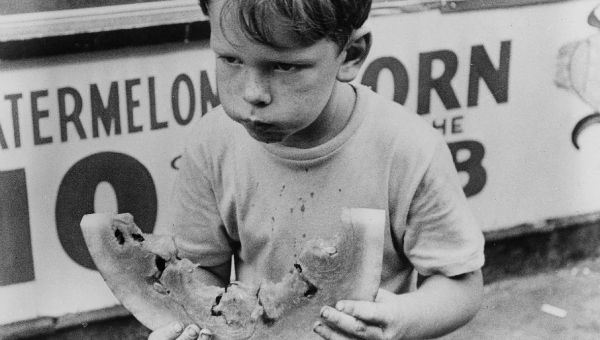
Six years before Truffaut’s LES QUATRE CENT COUPS, another film took a troubled youngster down to the edge of the sea. From the opening shots of Joey, a frustrated seven-year-old boy from Brooklyn, begging to be included in a ballgame with his older brother and his friends, LITTLE FUGITIVE (1953) plunges us into a world as seen from the point of view of a child. We are encouraged to identify with his desire to be taken seriously in a world of grown-ups, and also his sense of fear and loneliness as he goes on the run. From the naturalistic acting (Joey is played with boundless energy by Richie Andrusco, a non-professional actor) and tiny budget, to the unusual, experimental shots and camera angles, many of the stylistic hallmarks of the New Wave genre are already here.
Joey runs away from home to the refuge of nearby Coney Island. His mother is away; the local kids have tricked him into believing that he has shot his older brother. In the incongruous exuberance of the scenes which follow, as Joey experiences the thrills and adventure of the boardwalk and the funfair, we can clearly see how the film influenced Truffaut and other New-Wave filmmakers like Godard, Chabrol and Rohmer; something Truffaut himself would later acknowledge.
Written and directed by Ray Ashley, Morris Engel and Ruth Orkin, LITTLE FUGITIVE was shot with the use of a lightweight hand-held camera – a forerunner of the Steadicam – which lends a raw immediacy to the events which unfold. Morris Engel, also a photojournalist, was aware of the power of still photography and this shines through in a series of particularly memorable scenes where the light is captured beautifully: between the slats of a boardwalk as Joey walks beneath it, the fading light of the evening with the fair silhouetted against the sky and finally the descent into darkness as Joey settles down to a night under the stars.

Unlike the later French films, however, in LITTLE FUGITIVE innocence remains intact. LES QUATRE CENTS COUPS would depict the young, anarchic Antoine Doinel and show the consequences of his actions, in an unflinching portrayal of boyhood sliding into delinquency. But LITTLE FUGITIVE keeps Coney Island and its distractions firmly contained. Joey is rescued and taken home again; at the end of the film, he is back shooting his toy gun along with the cowboys on his flickering television screen, lost only in his dreams. In this regard, the film perhaps has more in common with Louis Malle’s ZAZIE DANS LE METRO (1960), a gleeful, escapist dream bookended by the departure and return of a parent. It certainly shares that film’s rebellious qualities and more surreal moments, which all add to the impression that we are seeing the world as a child understands or, rather, fails to understand it.
Francesca Steele recently argued that ‘the New Wave did Hollywood a favour by pointing out its flaws. But, ultimately it replaced one cinematic template with another’. In particular, she cites the ‘cardboard cut-out’ characters of the New Wave films as a failing. This criticism could also be levelled at LITTLE FUGITIVE, whose adult characters are two-dimensional at best. But they are adults as seen through the eyes of a child; it’s clear that this is all the characters other than Joey and his brother are meant to amount to. By pushing the supporting cast into the background, in each case the directors ensure the focus is placed firmly on the juvenile protagonists and their single-minded pursuit of excitement, to great effect. For all its ground-breaking techniques and links with film movements to come, LITTLE FUGITIVE – a sun-bathed nostalgic snapshot of childhood in early 1950s America – deserves to be seen for what it is: a moving, joyful and innovative film in its own right and on its own terms.
httpvh://youtu.be/OMG3rGcW1c0

